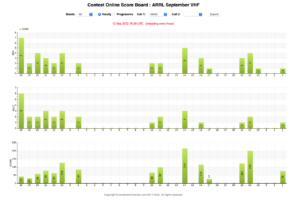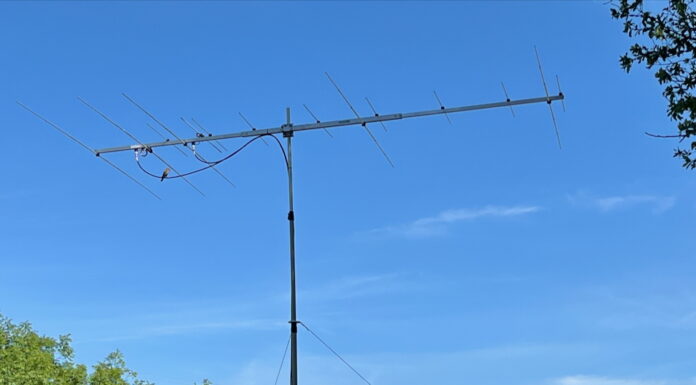Results
My station is now down to 6-meters and 2-meters only. In previous contests, the activity level above 2-meters was next to nothing, and getting people to move up to the next band was very challenging. So I’ve concentrated on building the 6 and 2-meter stations.
I managed 32 QSOs and 19 grids on 6 meters, along with 14 QSOs and 12 grids on 2 meters. Some of those were coordinated meteor scatter contacts. All were either FT8 or MSK144. I entered the low power category, limiting the power output on 6 and 2 to 200 watts.
 I figure 23 hours were spent in front of the rig with some time off for sleeping and watching Formula 1 with my wife. The Contest Scores Online website provided the nearby timeline of my QSOs. Looking over those few contacts, you can tell that I spent a fair amount of time looking at a blank screen or attempting to coordinate contacts on Ping Jocky and Slack VHF Chat.
I figure 23 hours were spent in front of the rig with some time off for sleeping and watching Formula 1 with my wife. The Contest Scores Online website provided the nearby timeline of my QSOs. Looking over those few contacts, you can tell that I spent a fair amount of time looking at a blank screen or attempting to coordinate contacts on Ping Jocky and Slack VHF Chat.
Preparation
Readers of this blog will note that I added a new 2-meter amplifier and an 8-element Quad. I also added a new preamp, bandpass filter, and TR switch for 2-meters, allowing me to use the Airspy SDR on 2-meters. I already had the same setup on 6-meters.
Before the contest, I ran into a challenge with running on 6-meters. The 2-meter amp was picking up the signal, and its transmit relay would chatter. I tried any number of fixes with ferrites, etc. I finally verified that it was not due to RFI on shack equipment from incoming coaxial cable shields or picking up RF on the various PTT and sequencer lines.
Changing the separation between the 6-meter and 2-meter antennas was the only thing that made any difference. On my pushup mast, the change was from 4 feet to 8 feet separation. That allowed transmitting on 6 meters at 150 watts, up from 100 watts. But 200 watts still sent the 2-meter amp into relay chatter.
Finally, I placed the bandpass filter on the output of the 2-meter amplifier rather than between the rig and amplifier. That worked to a treat with no problems encountered during the contest.
The SDR worked well on 6 and 2-meters with a bit of concern about changing transmit and receive frequencies separately. That only got to be troublesome at the end of the contest when I was trying to add just one more contact to the log after a tiring day from waking up at 4:30 AM to try some meteor scatter QSOs.
Next Activity
It’s been fun to make more contacts on 2 meters. I hope to add more grids during the upcoming meteor showers. I will also be on during the January VHF contest. Following that, it will be time to get the 6-meter 5-element Yagi onto the push-up mast for Es season and pursue the last 18 grids for FFMA.
Thanks to everyone who provided contacts for the September VHF contest.









[…] One Hams ARRL VHF Contest results Its been fun to make more contacts on 2 meters. I hope to add more grids during the upcoming meteor showers. K5ND […]